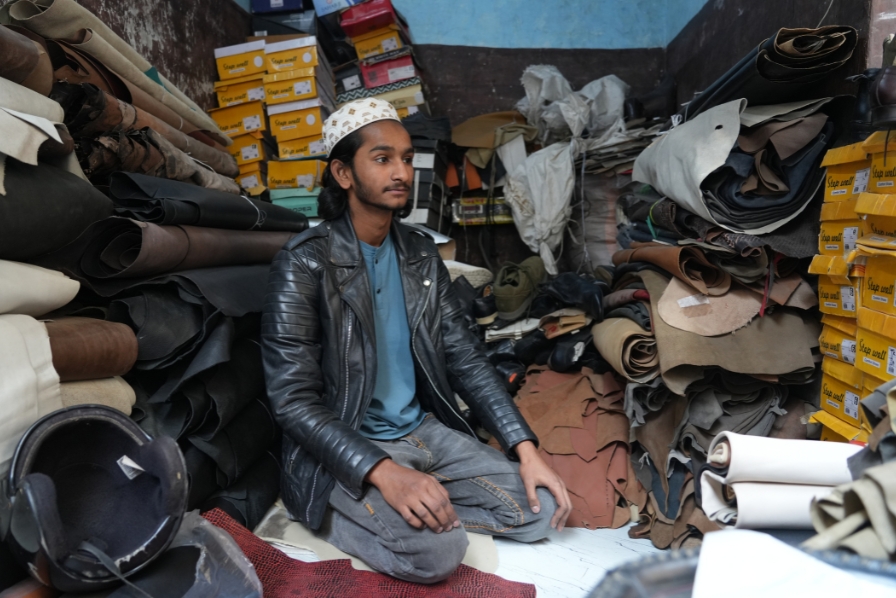Binnu Kain, 48, takes the mould in his hand after making the final shape. He says, “I have no other skills. Otherwise, I would have left this work. The decline of the leather industry has severely impacted those in the trade, making survival difficult. My children – a son and two daughters – after seeing this downfall, have lost interest in continuing the family business.”
Abdul, 48, a resident of Agra’s Sadar Bazar, has been in the shoemaking business for the last 35 years, following in his father’s footsteps. However, he was forced to shut down his factory two years ago and now sells raw materials like leather from a small shop near his home. He claims that the rising price of leather has significantly reduced demand, making it difficult for artisans like him to sustain their work. The price of leather rose sharply after the 2017 cattle slaughter ban making it harder and more expensive to source quality leather.
Faiz Ahmad, 19, is managing his father’s shop Real Leather located in Agra’s Sadar Bazaar, continuing his family’s three-generation legacy of making and selling leather shoes. He recalls that they once delivered shoes internationally, but now, customers rarely visit their shop.
Faiz says they received an order a few months ago for Italian-style shoes. However, after making the samples, the client backed out, citing high costs. He displays the sample shoes they had crafted for the order. The biggest competitors are in the Chinese market, where manufacturers compromise on craftsmanship to produce leather shoes at a much lower price.
Iftikhar and his brother have been making inner soles for shoes for 30 years. He complains that in the past five odd years, they have not received the same level of orders as before. Iftikhar also fears that in a few years, Agra’s shoe business may come to an end.
In Agra, Hing Ki Mandi is well known for its shoe raw materials, with hundreds of shops specialising in items such as laces, inner soles, outer soles, and other essentials. The market has been a hub for shoemakers for decades, supplying materials to both small artisans and large manufacturers. However, shop owners say rising costs and declining demand are making it harder to sustain their businesses.
Many small and large shoes are displayed in shops around Hing Ki Mandi. Over 300,000 pairs of shoes are made in this market every day, with top international brands like Nike, Clarks, and Reebok sourcing their products from here.
Rohan, 26, sits in his shop Unique Shoes in Sadar Bazaar, selling a variety of shoes, including leather and other types. However, with only a few customers visiting each day, his family’s livelihood has been severely affected. His family has been in this business for forty years now.
Also read: Glittering Punjabi juttis hide grim story of shoemakers
The lead image on top shows 48-year-old Binnu Kain. A resident of Sadar Bazar in Agra, he makes footwear moulds that provide the required shape for the final product. He has been working for the past 30 years, continuing the family business that his father started. Demand has dropped significantly – he used to make hundreds of shoe bases all day, but now only a few orders come in. The decline in work threatens his livelihood and the industry’s future.
Reporting and photography by Suhail Bhat, a multimedia journalist from Kashmir.















